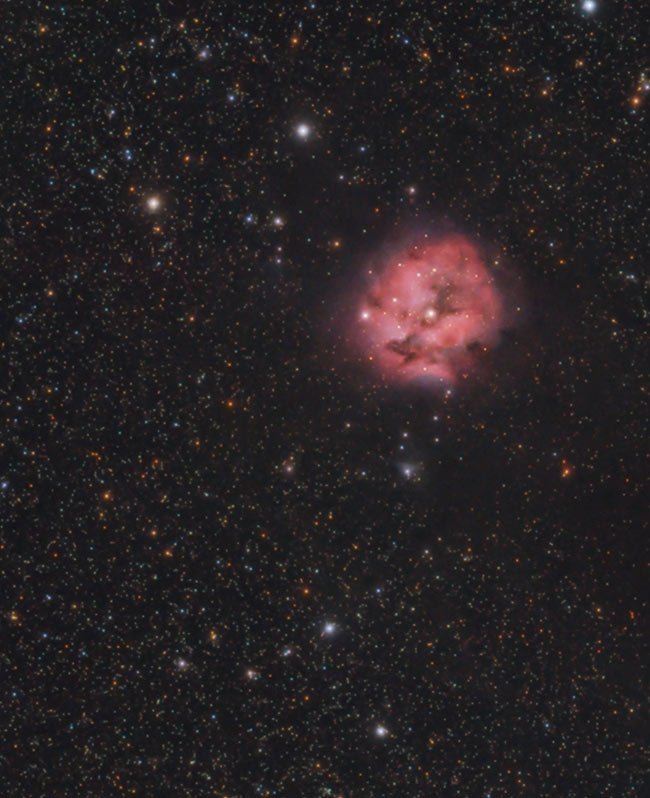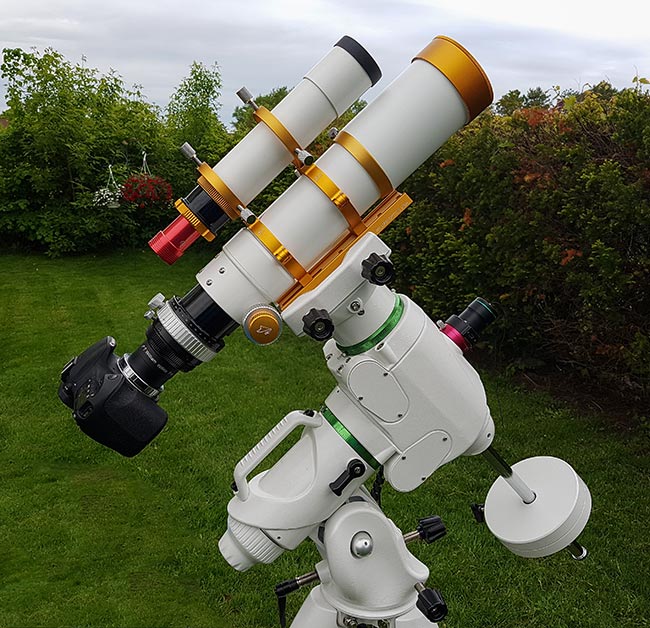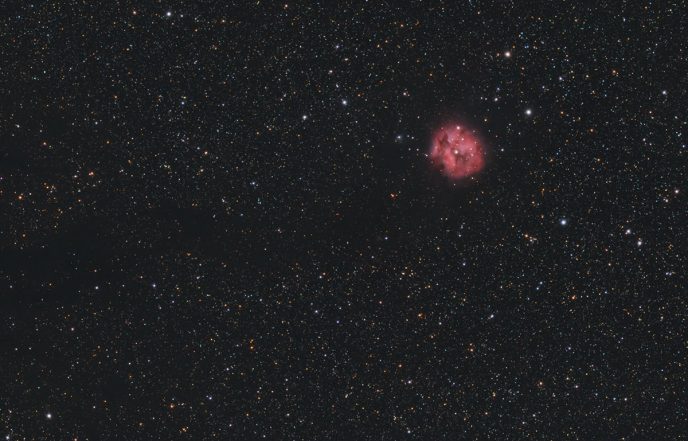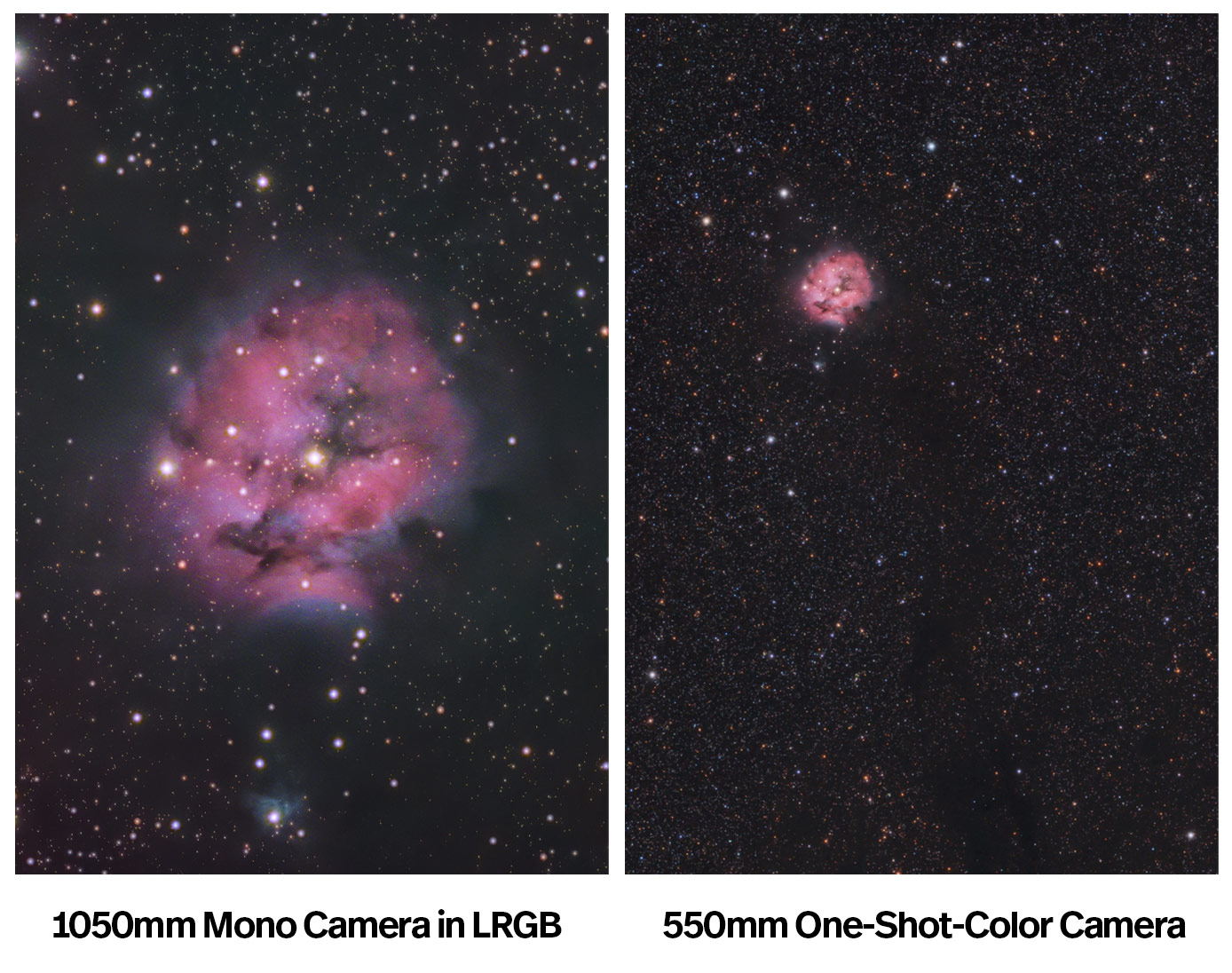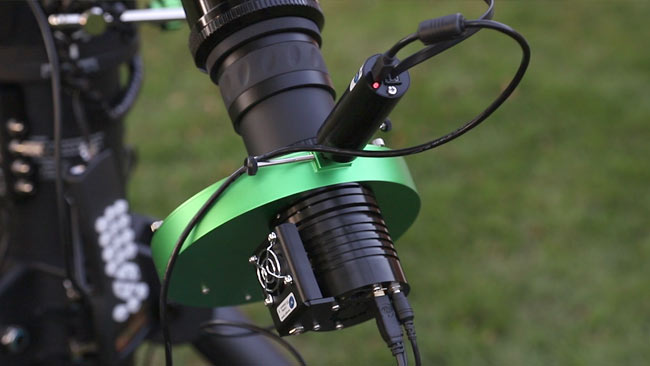The Cocoon Nebula
The Cocoon Nebula (IC 5146) is located in a crowded field of stars spanning approximately 2 degrees. This interesting emission/reflection nebula resides within the constellation Cygnus, which rises high overhead to stargazers in mid-northern latitudes like myself.
IC 5146 is a compact star-forming region, with a long trail of obscuring interstellar dust clouds. The NGC (new general catalogue) description refers to IC 5146 (also known as Collinder 470) as a “cluster of 9.5 magnitude stars involved in a bright and dark nebula”.
The picture shown below was captured using a camera and telescope from my backyard in the city.
The Cocoon Nebula in Cygnus. 6.6 Hour Exposure in LRGB (Trevor Jones).
IC 5146 – The Cocoon Nebula
This nebula is almost 15 light-years wide and located 4,000 light-years away. This APOD image illustrates how the bright star near the center of the Cocoon Nebula is powering the intense nebular glow, and clearing out a cavity in the areas of star-forming dust and gas.
This nebula is comprised of a molecular cloud, which is a giant condensation of dust and molecular gas. All stars are born in molecular clouds, and typically stand out in red, glowing hydrogen gas as seen in the Cocoon Nebula. The Cocoon Nebula is considered to be one of many “stellar nurseries“, as this is where new stars are being born.
Cocoon Nebula Details:
- Common Name: Cocoon Nebula
- Type: Reflection/emission Nebula with associated star cluster
- Cataloged: IC 5146, Caldwell 19, Sh 2-125
- Constellation: Cygnus
- Apparent Magnitude (V): 7.2
- Distance to Earth: 3,262 light-years
Location in Cygnus
IC 5146 is located at the edge of the constellation Cygnus, bordering on Cepheus. In the star map below, you’ll see that the Cocoon Nebula is well below the bright star Deneb, and the North America Nebula. It is a difficult object to observe visually because it is so faint. That is not to say that it can’t be done, but dark skies are required.
If you are using a camera and telescope on a computerized equatorial telescope mount, it is helpful to focus and align the telescope using Deneb nearby.
Through astrophotography, we can reveal the delicate structure and intense colors of this compact star-forming region. I have been photographing the Cocoon Nebula using amateur astrophotography equipment for several years, and each photo gets a little better.
The image shown below was captured using a color camera from my Bortle Class 6 backyard in Ontario, Canada.
The Cocoon Nebula in Cygnus. Captured using a camera and telescope
The photo shown above includes 3 hours of total integrated exposure time. The individual exposures were 4-minutes long each and were stacked and calibrated to produce an intermediate file using DeepSkyStacker. The image was then processed entirely in Adobe Photoshop CC.
Related: Download my Astrophotography Image Processing Guide.
The version (shown above) was captured using a Sky-Watcher Esprit 100 apochromatic refractor telescope. This telescope acts like a giant camera lens with a focal length of 550mm, and an f-ratio of F/5.
It is important to choose a camera and telescope system that meets the needs of your intended projects. However, the Cocoon Nebula is one of those targets that can be enjoyed at nearly any telescope focal length. A wider field of view will reveal a long tail of dust, and a longer focal length will capture intricate details of the emission/reflection nebula.
The camera and telescope used for my latest photo of the Cocoon Nebula.
For an up-close look at the Cocoon, have a look at this version taken using a 24″ RC telescope from the Mount Lemmon SkyCenter. Don’t expect to get results like this from your backyard using a small telescope!
Astrophotography Tips
A wide-field image of the Cocoon Nebula taken with a DSLR.
The wide-field view above should give you a good idea of the size of the Cocoon Nebula when photographed through a small refractor telescope. This image was captured using a Canon 60Da DSLR camera through a 73mm refractor telescope. This telescope has a focal length of 430mm, which many would say is too short a focal length for this target.
In this instructional video, you’ll get a behind the scenes look at the astrophotography equipment used to photograph this target. Although it may look complex to beginners, the setup used in this video is actually quite modest in the world of deep-sky astrophotography.
The photo below shows how I have my DSLR camera attached to the telescope for deep sky imaging.
The camera and telescope used to produce the version of the Cocoon Nebula shown above.
It’s true, capturing the Cocoon Nebula with a focal length of 1000mm or more would reveal much more of the structure of the glowing, star-forming region with red hydrogen gas and reflected dust. But that would not highlight the isolation of IC 5146 and the beautiful mix of stars surrounding it.
With that being said, I also enjoy photographing the Cocoon Nebula using longer focal lengths. The great thing about astrophotography is that you can add new data to existing projects over time.
The Hutech IDAS Night Glow Suppression filter helped block the white LED street lights that surround my house. Have a look at the transmission graph of this filter here.
When it comes to photographing the Cocoon Nebula, I feel that it is important to showcase the sea of colorful stars that surround this nebula. When capturing IC 5146 with a small telescope, the emission/reflection nebula itself appears quite small, but the tail of dust extends for several degrees in the night sky.
It can be challenging to shoot RGB (broadband) images using a DSLR camera from the city, which is why I suggest using a mild light pollution filter to help create contrast between your subject and a washed-out sky.
The filter used for the photo above was an IDAS NGS1 (Night sky glow suppression), and I think that it did a wonderful job at preserving the natural colors of the surrounding stars.
One-Shot-Color Camera
The image below was captured using a one-shot-color cooled CMOS camera, through a 100mm refractor telescope. A cooled astronomy camera is very handy when capturing true-color images in broadband RGB because it keeps thermal noise under control. The camera was a ZWO ASI294MC Pro.
A dedicated astronomy camera with cooling is a great way to photograph this deep-sky object, as you will be able to collect long-exposure images with much less thermal noise than you would with a DSLR or mirrorless camera.
The Cocoon Nebula captured with a dedicated astronomy camera in broadband RGB. (Click for larger version)
The image above used 65 frames at 3-minutes each. The images were stacked and calibrated in DeepSkyStacker, with final processing in Adobe Photoshop. The IDAS NGS1 filter was extremely impressive on this target, and the star colors were absolutely incredible.
When shooting wide-field images like this, I find flat field calibration frames (flat frames) to be particularly important. This is because a wider field often includes gradients in the sky that can be tough to correct in post-processing.
It is interesting to see the drastic difference in the apparent size of the Cocoon Nebula captured through different imaging configurations. On top of using a longer focal length for the LRGB image on the left, the sensor on the monochrome CCD camera creates a much narrower field of view than a typical DSLR (APS-C) sized sensor.
Updated Image
In the summer of 2020, I collected new data on the Cocoon Nebula using a monochrome CCD camera (Starlight Xpress Trius 694). This time, I photographed the Cocoon Nebula using LRGB filters, capturing black-and-white images through each filter.
Along with using a monochrome camera, I captured the images using a telescope with much more focal length than ever before. The Sky-Watcher Esprit 150 APO has a focal length of 1050mm.
The following image includes 6.6 hours of total exposure time from my backyard in Ontario, Canada.
The Cocoon Nebula in LRGB.
At this magnification, the long tail of dust is not recorded. However, the interesting details within the emission/reflection nebula are much more clear.
Photo Details:
- Luminance Filter: 1 Hour, 30 Minutes
- Red Filter: 1 Hour, 40 Minutes
- Green Filter: 1 Hour, 49 Minutes
- Blue Filter: 1 Hour, 39 Minutes
Taking images over multiple nights through color filters requires a little more work in terms of calibration. You must shoot flat frames for each filter, and apply them to your stack of sub-exposures to correct gradients and dust spots on the sensor.
The individual image exposures were 4 and 5-minutes each. To improve the tracking accuracy of my telescope mount (Sky-Watcher EQ8-R Pro), I utilized an autoguiding system involving the Starlight Xpress Lodestar X2 guide camera.
Below, is a picture of this camera configuration attached to my telescope.
The Starlight Xpress SX-42 Camera System (Trius 694 Mono).
I use a laptop computer with a number of astrophotography-specific software applications installed to control my imaging sessions. To review all of the astronomy software I recommend, have a look at the resources page of this website.
In Narrowband H-Alpha
The regions of hydrogen gas in the Cocoon Nebula can be isolated using a narrowband h-alpha filter with your astrophotography camera. This is best accomplished using a monochrome camera, but a color camera will still record a useful signal with enough exposure time.
The image below shows the Cocoon Nebula photographed using an h-alpha filter on my DSLR camera. The emission nebula portion of the Cocoon Nebula is surprisingly bright when captured with a hydrogen-alpha filter in a long exposure image.
The Cocoon Nebula in H-Alpha.


